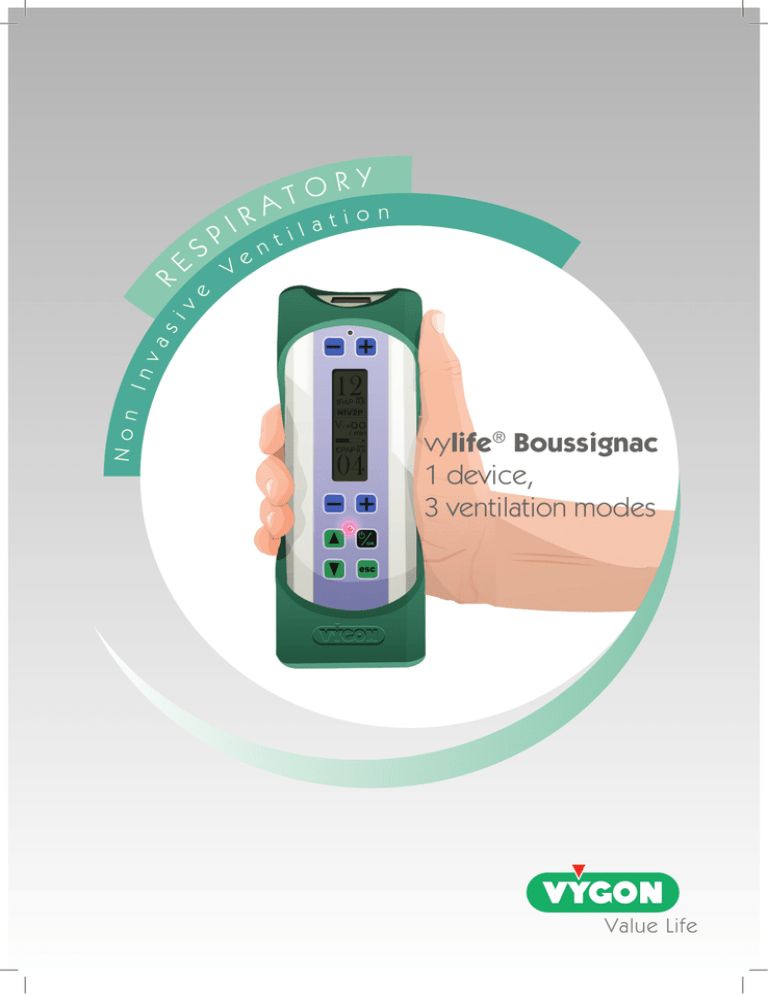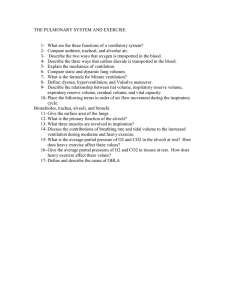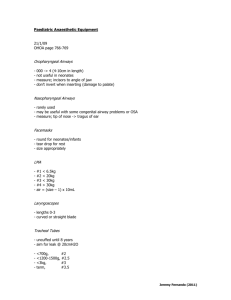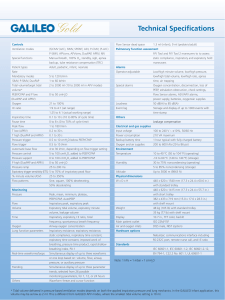E IR T Y vylife® Boussignac 1 device, 3 ventilation modes
advertisement

R S e ion t a il t en R I P V Non In va si v E A RY O T vylife® Boussignac 1 device, 3 ventilation modes vylife® Boussignac vylife® Boussignac, 1 device, 3 ventilation modes APNEA mode NIV-2P mode Return to spontaneous ventilation following cardiac arrest Non Invasive Ventilation with 2 levels of pressure Mechanical ventilation APNEA Mode Transport of intubated patient cmH2O 12 11 Interest of mechanical ventilation: • Pressure control • Physiological mechanical ventilation: in open system, lung elastance and compliance regulates the speed and volume of gas Insp. Respiratory cycle in NIV-2P IPAP 10 15 9 12 10 8 5 6 4 3 7 5 6 Exp. 5 EPAP 1 2 0 Temps 4 CPAP mode 3 Continuous Positive Airway Pressure (one pressure level) 1 0 -1 cmH2O 12 11 10 9 8 7 6 5 4 3 2 1 Spontaneous 0 ventilation EPAP: Expiratory Positive Airway Pressure Inspiratory trigger 3 IS (Inspiratory Support) = IPAP-EPAP 4 Slope: speed from expiratory pressure to inspiratory pressure 5 IPAP: Inspiratory Positive Airway Pressure 6 Expiratory trigger 1 2 DELTA P The Work Of Breathing (WOB) is the expenditure of energy required to inspire air in the lungs. WOB CPAP 7.5 cmH2O Exp. Insp. 2 Exp. Insp. Time IPAP : Inspiratory Positive Airway Pressure EPAP : Expiratory Positive Airway Pressure Delta P DELTA P 0 1 2 3 4 5 6 7 9 8 10 11 12 Atmospheric pressure is the difference between inspiratory pressure and expiratory pressure. COPD (Chronic Obstructive Pulmonary Disease) and Pneumopathy with hypoxemia Time Alveolar recruitment Improvement of ventilation / perfusion ratio APE (Acute Pulmonary Edema) COPD, Pneumopathy with hypoxemia Alveolar recruitment Pulmonary volume Improvment of ventilation / perfusion ratio Decrease the WOB APE Hypoxemia Hemodynamic Hypercapnia PEP (Positive Expiratory Pressure) Decrease the WOB Increase of tidal volume Decrease the WOB NIV-2P mode IS (Inspiratory Support) CPAP mode Decrease of venous return Decrease of left ventricular afterload Proven interest of CPAP: Proven interest of NIV-2P (5,6): • Increased gazometric and ventilator parameters • Decreased morbidity and mortality • Decreased length of stay • Reduced risk of reintubation • Proven efficiency in the management of acute pulmonary edema (1,2) • Avoids the need for tracheal intubation (3) • Cost/benefit ratio shows a positive result in favour of CPAP in pre-hospital medical care (4) 2 3 vylife® Boussignac vylife® Boussignac: all the advantages of Boussignac CPAP + a trigger 1 Effective CPAP mode (7,8) • Flow rate of gas available for inspiration is 280 to 320 l/min • The difference between inspiratory pressure and expiratory pressure (Delta P) is only 1.5 +/- 0.2 cmH2O (9) • Regulation of inspired FiO2 3 Easy to use • vylife® Boussignac starts with the chosen mode of ventilation and pressures • Adjustable pressure with buttons “+” and “-” • Inspiratory Support (IS)=IPAP-EPAP • Portable • Capnograph connection via interface or manometer port Mode VNI-2P (10, 11) • Pressurisation quality • Accurate trigger Easy to use: + increases pressure - decreases pressure 2 Safe vylife® Boussignac is an open system, if necessary the patient can breathe atmospheric air and thus constantly breathe the required volume of gas. The pressure in the lungs cannot be superior to the virtual valve (A): Oxygen supply Oxygen acceleration Oxygen molecules arrive in the chamber Large screen: Easy to read (ventilation mode, pressures, battery, respiratory frequency) Open system: no risk of asphyxia The oxygen molecules are accelerated at the speed of sound when they pass trough four micro-channels Open to atmosphere Pressure (A) Flow rate of gas available 280 – 320 L/min Disposable kit: ready to use Creation of a virtual valve The oxygen molecules collide with each other, generating turbulence which transforms the speed into pressure Oxygen breaking The oxygen molecules strike a deflector which sends them back to the central zone (mixing zone) Pressure directly depends on flow rate of gas Pressure monitoring or administration of additional oxygen or EtCO2 monitoring When you increase the flow rate, you increase the pressure When you decrease the flow rate, you decrease the pressure No risk of barotrauma / volotrauma No risk of hypoventilation 4 One click connection: no risk of misconnection Special “star” shaped O2 tube: Thanks to this design, the patient will always get O2 even if the tube is kinked 5 Complete range Single use kit vylife® kit without harness vylife® kit with harness Codes 5567.303 / 403 / 503 / 603 Codes 5568.303 / 403 / 503 / 603 Oxygen extension tube Ringed tube CPAP Boussignac FiO2 ring Trigger Facial mask Oxygen extension tube Ringed tube CPAP Boussignac FiO2 ring Trigger Facial mask O2 vylife® kit Codes 5582.802 (AFNOR) 2 vylife® kits 1 vylife® charger 1 vylife®device 1 Rapid instructions for use 1 Oxygen stopcock Codes 5582.700 (without Oxygen stopcock) 5568.303 / 403 / 503 / 603 2 vylife® kits 1 vylife® charger 1 vylife®device 1 Rapid instructions for use 5568.303 / 403 / 503 / 603 References Hubble Mw, and al. Effectiveness of continuous positive airway pressure in the management of acute pulmonary edema. Prehosp Emerg Care. 2006;10:430-439 (2) Gray A et al. Noninvasive ventilation in acute cardiogenic pulmonary edema. N Engl J Med. 2008;359:142-151 (3) Wang He, and al. Medical conditions associated with out-of-hospital intubation. Prehosp Emerg Care. 2011;15:338-346 (4) Hubble MW, and al. Estimates of cost-effectiveness of prehospital continuous positive airway pressure in the management of acute pulmonary edema. Prehosp Emerg Care. 2008;12:277-285 (5) Meduri Gu and al. Noninvasive positive pressure ventilation via face mask. First-line intervention in patients with acute hypercapnic and hypoxemic respiratory failure. Chest 1996 Jan;109(1):179-93 (6) Ram FS and al. Non-invasive positive pressure ventilation for treatment of respiratory failure due to exacerbations of chronic obstructive pulmonary disease. Cochrane DatabaseSyst Rev. 2004;(3):CD004101 (7) Templier F and al. Ann Fr Anest Reanim 2003 ;22 :103-7 (8) Lyazidi A and al. Evaluation des systèmes à Pression Positive Continue (CPAP) sur banc d’essai. Hôpitaux Universitaires de Genève (9) P.Valero MD, A. Khoury MD, G. Capellier MD, Phd, D. Robert MD, Phd. Comparison between 3 devices delivering Continuous Positive Airway Pressure (CPAP). Poster (10) Brochard L. et al. Evaluation d’un nouvel appareil de ventilation assistée portable : la Vylife Boussignac. Poster SRLF 2009 (11) Jaber S. et al. Un nouveau ventilateur «léger», la Vylife - BiPAP Boussignac : évaluation sur banc test. Poster SFAR 2012 (1) AUGUST 2013 / DB CPAP 13 207 E For further information, please contact: questions@vygon.com The specifications shown in this leaflet are for information only and are not, under any circumstances, of a contractual nature. Vygon – 5, rue Adeline • 95440 ECOUEN • FRANCE Reception: +33 (0)1.39.92.63.63 – Service clients France: +33 (0)1.39.92.63.81 Export customer service: +33 (0)1.39.92.64.15 Fax: +33 (0)1.39.92.64.44 • www.vygon.com www.vygon.com





